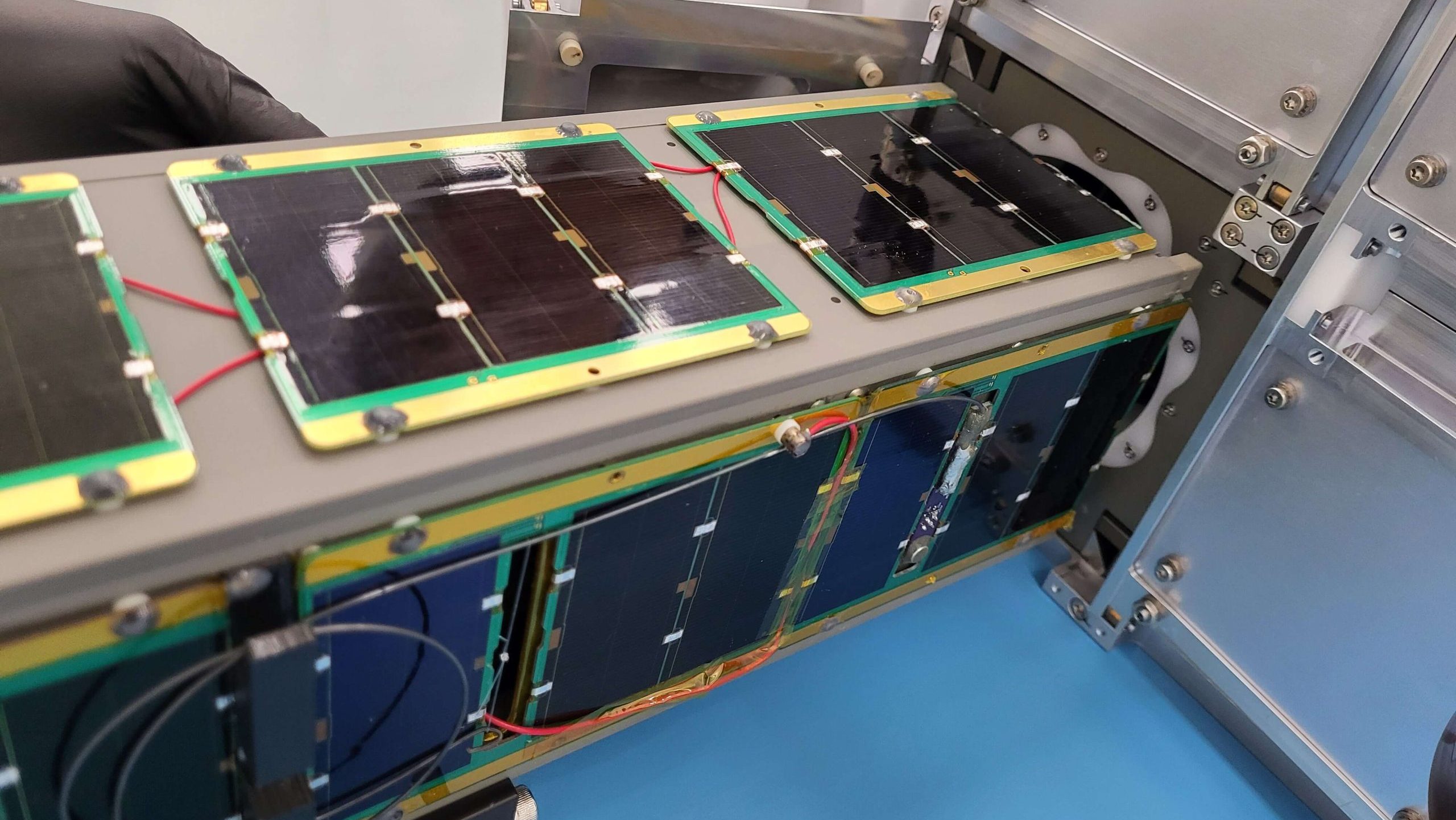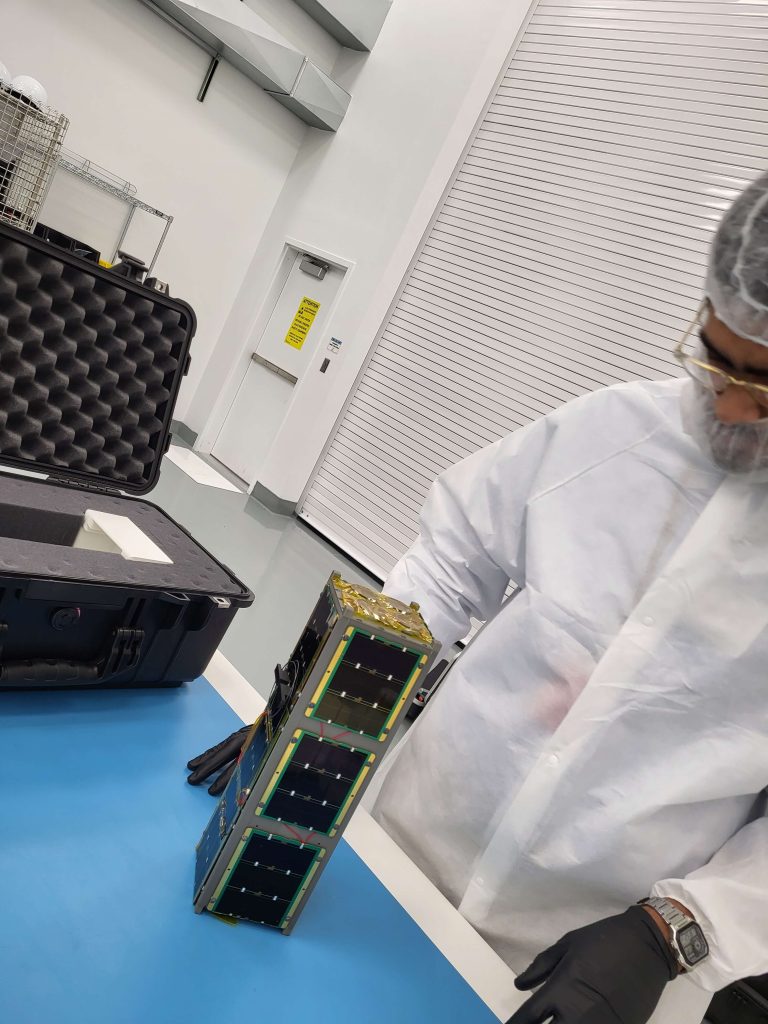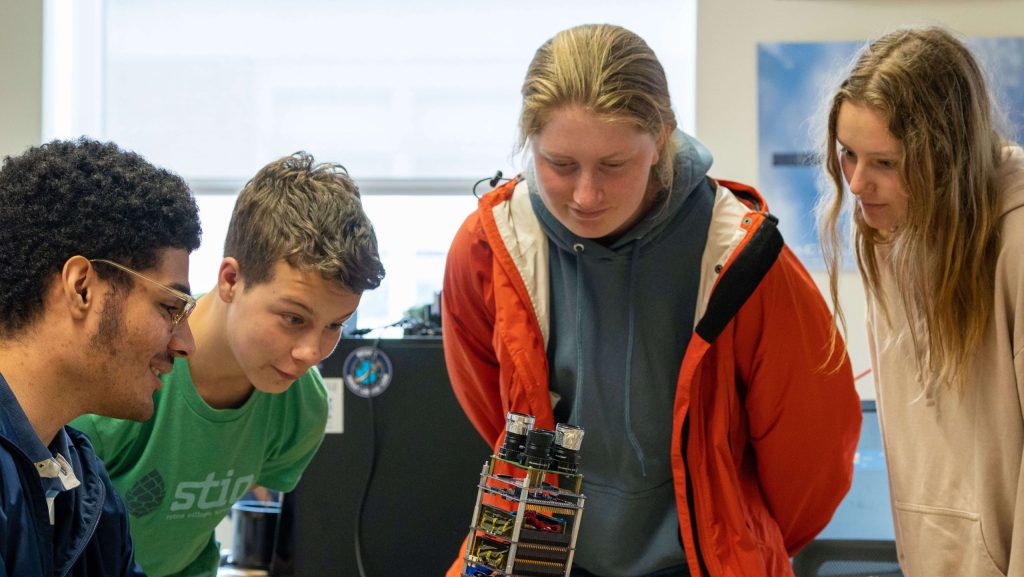
Maine’s first research satellite to launch this year
Maine’s first small research satellite, designed to engage middle and high school students in STEM, is expected to launch into orbit within the next couple of months.
Firefly Aerospace, a company based in Cedar Rapids, Texas, integrated the nearly 1 foot tall satellite, known as MESAT1, into a rocket to be launched from the Vandenberg Space Force Base in Southern California. The integration was conducted inside Firefly’s clean room in Vandenberg by Joseph Patton, a Ph.D. student at the University of Maine Department of Electrical and Computer Engineering, and Ali Abedi, principal investigator for the project and professor of electrical and computer engineering.
 MESAT1 is a cube satellite, or CubeSat, a type of nanosatellite that offers cost effective opportunities for research. Students and faculty from UMaine designed, built and tested the components for MESAT1 in collaboration with the University of Southern Maine, a trio of K-12 schools, the Radio Amateur Satellite Corporation and the Wells National Estuarine Research Reserve. The $522,000 project is supported by grants from NASA and Maine Space Grant Consortium.
MESAT1 is a cube satellite, or CubeSat, a type of nanosatellite that offers cost effective opportunities for research. Students and faculty from UMaine designed, built and tested the components for MESAT1 in collaboration with the University of Southern Maine, a trio of K-12 schools, the Radio Amateur Satellite Corporation and the Wells National Estuarine Research Reserve. The $522,000 project is supported by grants from NASA and Maine Space Grant Consortium.
An exact day and time for the launch will be announced at a later date.
“Integrating the satellite into the dispenser on board the launch vehicle is the most important milestone before launch,” said Abedi, who also serves as associate vice president of research at UMaine. “This signifies culmination of five years of research and development, building, testing, licensing and flight certification.”
Once launched into Earth’s low orbit, MESAT1 will orbit from six months to two years, providing students and teachers in Maine access to space data for educational and research purposes. Developers hope access to satellite data will encourage students to pursue STEM careers.
“Working on the MESAT1 project has been a challenging and educational opportunity, and it’s exciting to finally get to launch the spacecraft into orbit,” Patton said.
The satellite is equipped with three cubic-shaped payloads designed by students in Falmouth High School, Fryeburg Academy and Saco Middle School who are conducting individual experiments. Equipped with four cameras, the satellite will offer data for these experiments by periodically taking pictures of Earth and sending them back to the ground station at UMaine, where the satellite will be controlled.
The payload from Saco Middle School, dubbed ALBEDO, will investigate the impact of albedo — the fraction of solar irradiation reflected back into space — on local temperature. The goal is to compare temperature and albedo across urban and rural areas and determine whether urban heat islands can be mitigated through architectural designs that maximize albedo.

Fryeburg Academy’s payload, IMAGER, will be used to study an application of a low-cost remote sensing tool for coastal estuaries. Through modifying a digital camera, the project team will develop a remote sensing tool to image shallow, coastal waters. Capturing these images will allow the group to distinguish water quality properties such as turbidity and phytoplankton concentration.
The third payload from Falmouth High School, HAB, will study harmful algal blooms to see if they increase atmospheric temperature and water vapor levels in the atmosphere above them. Developing the capacity to monitor and identify algal blooms from orbit will provide a simple way to track the development, distribution and dispersion of blooms.
The projects from Falmouth High School, Fryeburg Academy and Saco Middle School were chosen from 11 proposals submitted during a statewide competition for schools hosted by the Maine Space Grant Consortium in 2019.
MESAT1 is one of 18 small research satellites selected by NASA to carry auxiliary payloads into space as part of its CubeSat Launch Initiative. The program provides opportunities for nanosatellite science and technology payloads built by universities, schools and nonprofit organizations to rideshare on space launches.
The satellite is one of several projects from the UMaine Space Initiative, which brings together faculty, administrators, staff and students to advance Maine’s space-based economy and help build a skilled workforce in the field. Additionally, efforts are underway to develop a new Maine SpacePort Complex to develop, manufacture and launch nanosatellites into polar orbit. The complex will include an Innovation Hub with research, development and manufacturing facilities.
